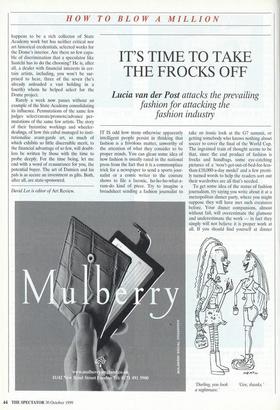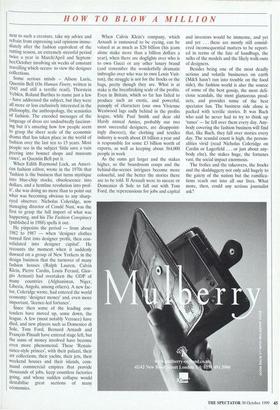IT'S TIME TO TAKE THE FROCKS OFF
Lucia van der Post attacks the prevailing fashion for attacking the fashion industry
IT IS odd how many otherwise apparently intelligent people persist in thinking that fashion is a frivolous matter, unworthy of the attention of what they consider to be proper minds. You can glean some idea of how fashion is usually rated in the national press from the fact that it is a commonplace trick for a newspaper to send a sports jour- nalist or a comic writer to the couture shows to file a laconic, ho-ho-ho-what-a- rum-do kind of piece. Try to imagine a broadsheet sending a fashion journalist to take an ironic look at the G7 summit, or getting somebody who knows nothing about soccer to cover the final of the World Cup. The ingrained train of thought seems to be that, since the end product of fashion is frocks and handbags, some eye-catching pictures of a 'won't-get-out-of-bed-for-less- than-£10,000-a-day model' and a few pretti- ly turned words to help the readers sort out their wardrobes are all that's needed.
To get some idea of the status of fashion journalism, try saying you write about it at a metropolitan dinner party, where you might suppose they will have met such creatures before. Your dinner companions, almost without fail, will overestimate the glamour and underestimate the work — in fact they simply will not believe it is proper work at all. If you should find yourself at dinner 'Darling, you look a nightmare.' 'Gee, thanks.' next to such a creature, take my advice and refrain from expressing said opinions imme- diately after the fashion equivalent of the rutting season, an extremely stressful period twice a year in March/April and Septem- ber/October involving six weeks of constant travelling which occurs to view the designer collections.
Some serious minds – Alison Lurie, Quentin Bell (On Human Finery, written in 1945 and still a terrific read), Thorstein Veblen, Roland Barthes to name just a few – have addressed the subject, but they were all more or less exclusively interested in the philosophy, the anthropology, the semiotics of fashion. The encoded messages of the language of dress are undoubtedly fascinat- ing but it's amazing how few people seem to grasp the sheer scale of the economic drama that has taken place in the world of fashion over the last ten to 15 years. Most people see in the subject 'little save a vain Peering into bonnet shops and museum cases', as Quentin Bell put it.
When Edith Raymond Lock, an Ameri- can fashion editor, wrote in the 1970s that 'fashion is the business that turns mystique into blue-chip stocks, obsolescence into dollars, and a hemline revolution into prof- it', she was doing no more than to point out what was becoming obvious to any sharp- eyed observer. Nicholas Coleridge, now managing director of Conde Nast, was the first to grasp the full import of what was happening. and his The Fashion Conspiracy (published in 1988) spells it out.
He pinpoints the period — from about 1982 to 1987 — when 'designer clothes turned first into designer profit, then con- solidated into designer capital'. He recounts the moment when it suddenly dawned on a group of New Yorkers in the design business that the turnover of many fashion houses (Ralph Lauren, Calvin Klein, Pierre Cardin, Louis Feraud, Gior- gio Armani) had overtaken the GDP of many countries (Afghanistan, Niger, Liberia, Angola, among others). A new fac- tor, Coleridge wrote, had entered the world economy: 'designer money' and, even more important, 'licence-led fortunes'.
Since then some of the leading con- tenders have moved up, some down, the league. A few (most notably Versace) have died, and new players such as Domenico di Sole, Tom Ford, Bernard Arnault and Francois Pinault have entered stage left, but the sums of money involved have become even more phenomenal. These 'Renais- sance-style princes', with their palazzi, their art collections, their yachts, their jets, their weekend houses and their islands, com- mand commercial empires that provide thousands of jobs, keep countless factories going, and whose sudden collapse would destabilise great sections of many economies. When Calvin Klein's company, which Arnault is rumoured to be eyeing, can be valued at as much as $20 billion (his jeans alone make more than a billion dollars a year), when there are dogfights over who is to own Gucci or any other luxury brand (and remember the wonderfully dramatic imbroglio over who was to own Louis Vuit- ton), the struggle is not for the frocks or the bags, pretty though they are. What is at stake is the breathtaking scale of the profits. Even in Britain, which so far has failed to produce such an exotic, and powerful, panoply of characters (our own Vivienne Westwood lags sadly behind in the profits league, while Paul Smith and dear old Hardy annual Alines, probably our two most successful designers, are disappoint- ingly discreet), the clothing and textiles industry is worth about £8 billion a year and is responsible for some £3 billion worth of exports, as well as keeping about 364,000 people in work As the sums get larger and the stakes higher, so the boardroom coups and the behind-the-scenes intrigues become more colourful, and the better the stories there are to be told. If Arnault were to sneeze or Domenico di Sole to fall out with Tom Ford, the repercussions for jobs and capital and investors would be immense, and yet and yet ... these are mostly still consid- ered inconsequential matters to be report- ed in terms of the fate of handbags, the sulks of the models and the likely walk-outs of designers.
Besides being one of the most deadly serious and volatile businesses on earth (M&S hasn't run into trouble on the food side), the fashion world is also the source of some of the best gossip, the most deli- cious scandals, the most glamorous prod- ucts, and provides some of the best spectator fun. The business side alone is packed with terrific stories. It was Bach who said he never had to try to think up 'tunes' — he fell over them every day. Any- body covering the fashion business will find that, like Bach, they fall over stories every day. The scandal count is high, the person- alities vivid (read Nicholas Coleridge on Cardin or Lagerfeld . .. or just about any- body else), the stakes huge, the fortunes vast, the social impact enormous.
The frolics and the takeovers, the frocks and the skulduggery not only add hugely to the gaiety of the nation but the ramifica- tions reach out into all our lives. What more, then, could any serious journalist ask?



























































































 Previous page
Previous page